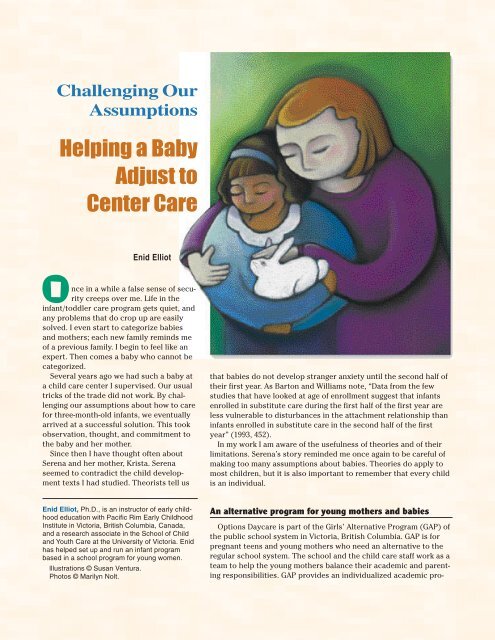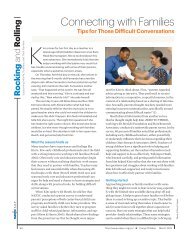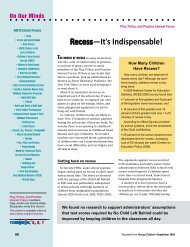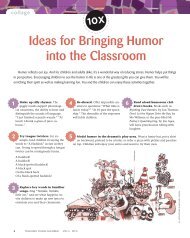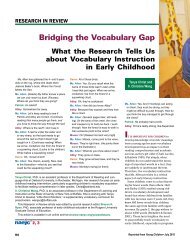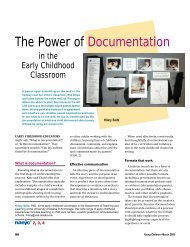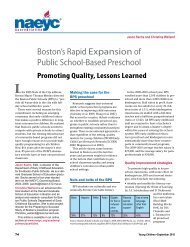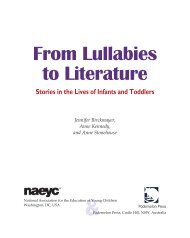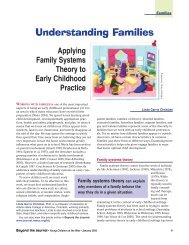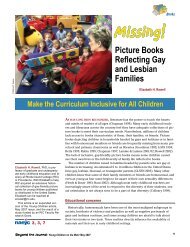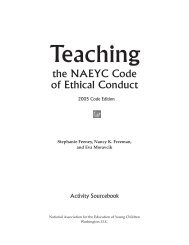Challenging Our Assumptions: Helping a Baby Adjust to Center Care
Challenging Our Assumptions: Helping a Baby Adjust to Center Care
Challenging Our Assumptions: Helping a Baby Adjust to Center Care
You also want an ePaper? Increase the reach of your titles
YUMPU automatically turns print PDFs into web optimized ePapers that Google loves.
<strong>Challenging</strong> <strong>Our</strong><br />
<strong>Assumptions</strong><br />
<strong>Helping</strong> a <strong>Baby</strong><br />
<strong>Adjust</strong> <strong>to</strong><br />
<strong>Center</strong> <strong>Care</strong><br />
Enid Elliot<br />
Once in a while a false sense of security<br />
creeps over me. Life in the<br />
infant/<strong>to</strong>ddler care program gets quiet, and<br />
any problems that do crop up are easily<br />
solved. I even start <strong>to</strong> categorize babies<br />
and mothers; each new family reminds me<br />
of a previous family. I begin <strong>to</strong> feel like an<br />
expert. Then comes a baby who cannot be<br />
categorized.<br />
Several years ago we had such a baby at<br />
a child care center I supervised. <strong>Our</strong> usual<br />
tricks of the trade did not work. By challenging<br />
our assumptions about how <strong>to</strong> care<br />
for three-month-old infants, we eventually<br />
arrived at a successful solution. This <strong>to</strong>ok<br />
observation, thought, and commitment <strong>to</strong><br />
the baby and her mother.<br />
Since then I have thought often about<br />
Serena and her mother, Krista. Serena<br />
seemed <strong>to</strong> contradict the child development<br />
texts I had studied. Theorists tell us<br />
Enid Elliot, Ph.D., is an instruc<strong>to</strong>r of early childhood<br />
education with Pacific Rim Early Childhood<br />
Institute in Vic<strong>to</strong>ria, British Columbia, Canada,<br />
and a research associate in the School of Child<br />
and Youth <strong>Care</strong> at the University of Vic<strong>to</strong>ria. Enid<br />
has helped set up and run an infant program<br />
based in a school program for young women.<br />
lllustrations © Susan Ventura.<br />
Pho<strong>to</strong>s © Marilyn Nolt.<br />
that babies do not develop stranger anxiety until the second half of<br />
their first year. As Bar<strong>to</strong>n and Williams note, “Data from the few<br />
studies that have looked at age of enrollment suggest that infants<br />
enrolled in substitute care during the first half of the first year are<br />
less vulnerable <strong>to</strong> disturbances in the attachment relationship than<br />
infants enrolled in substitute care in the second half of the first<br />
year” (1993, 452).<br />
In my work I am aware of the usefulness of theories and of their<br />
limitations. Serena’s s<strong>to</strong>ry reminded me once again <strong>to</strong> be careful of<br />
making <strong>to</strong>o many assumptions about babies. Theories do apply <strong>to</strong><br />
most children, but it is also important <strong>to</strong> remember that every child<br />
is an individual.<br />
An alternative program for young mothers and babies<br />
Options Daycare is part of the Girls’ Alternative Program (GAP) of<br />
the public school system in Vic<strong>to</strong>ria, British Columbia. GAP is for<br />
pregnant teens and young mothers who need an alternative <strong>to</strong> the<br />
regular school system. The school and the child care staff work as a<br />
team <strong>to</strong> help the young mothers balance their academic and parenting<br />
responsibilities. GAP provides an individualized academic pro-<br />
Young Children • July 2003 1
Behaviors That Challenge Children and Adults<br />
gram for young mothers, so a student is not penalized, for<br />
example, if her baby is sick and she must take time off.<br />
Options serves 12 babies; four caregivers look after<br />
the babies while their supervisor supports them in a<br />
multitude of ways. Usually six younger infants are in<br />
one group, with six older infants, 9 <strong>to</strong> 18-plus months, in<br />
another. We keep an anecdotal log on each baby as well<br />
as pho<strong>to</strong>s and videos. The log is used <strong>to</strong> communicate<br />
with the mother about her<br />
baby’s day; it is informal<br />
and, understandably,<br />
positive in <strong>to</strong>ne.<br />
<strong>Our</strong> experience with one<br />
baby—A case study<br />
When I began <strong>to</strong> recall our<br />
experiences with Serena, I<br />
had her anecdotal record<br />
and video <strong>to</strong> work from. I<br />
interviewed Serena’s mother<br />
and her former caregiver <strong>to</strong> get a fuller picture. This<br />
case study is based on the interviews and a review of<br />
the informal written and videotape records covering a<br />
10-month period, September <strong>to</strong> June. The names of<br />
everyone involved have been changed.<br />
Serena’s arrival<br />
Theories do apply<br />
<strong>to</strong> most children,<br />
but it is also important<br />
<strong>to</strong> remember<br />
that every child<br />
is an individual.<br />
It was Options’ third year of operation with the same<br />
group of caregivers when three-month-old Serena<br />
arrived at the center. We worked well as a team, employing<br />
a coherent philosophy of sensitive and responsive<br />
caregiving. Each baby was assigned a primary<br />
caregiver who established the main relationship with<br />
both mother and child. Children stayed with their<br />
caregivers, if at all possible, throughout their two years<br />
in the program.<br />
The staff worked as primary caregivers within a team<br />
framework. <strong>Our</strong> team had solved a number of problems<br />
<strong>to</strong>gether and felt that the babies developed a sense of<br />
security and well-being in our program. <strong>Our</strong> approach<br />
was <strong>to</strong> observe and respond sensitively <strong>to</strong> each baby.<br />
We worked at creating a calm and unhurried atmosphere.<br />
Her family<br />
Krista had been in GAP while she was pregnant.<br />
When her baby was born, she continued in<br />
school and brought Serena <strong>to</strong> the child care<br />
center. Krista was a very sociable 18-year-old who liked<br />
school and did well in her classes.<br />
Krista gave birth <strong>to</strong> Serena on June 12, two weeks<br />
early. She weighed five pounds, eight ounces. Krista<br />
lived in a group home with Serena and other young<br />
mothers and their babies. Serena’s father Don was very<br />
attentive, involved in her life from the beginning. In<br />
November Don and Krista moved in <strong>to</strong>gether (and<br />
subsequently married). Both parents were very attached<br />
<strong>to</strong> Serena. Her father regularly spent time with<br />
her at child care.<br />
Serena’s primary caregiver, Harriet<br />
At three months Serena started our program at<br />
the beginning of the school year in September. Her<br />
primary caregiver, Harriet, had met Serena at a<br />
drop-in program we ran during summer vacation.<br />
Harriet recalls that six-week-old Serena was not<br />
comfortable when she first held her then, relaxing<br />
only when she was returned <strong>to</strong> her mother.<br />
From a very young age, Serena preferred her<br />
mother <strong>to</strong> all others and was often anxious when<br />
separated from her. Experience had taught us that<br />
when babies enter the child care center at three<br />
months old, they have a period of adjustment as<br />
they become accus<strong>to</strong>med <strong>to</strong> our environment and their<br />
assigned caregiver. It also takes time for the caregiver<br />
2 Young Children July 2003
<strong>to</strong> adjust <strong>to</strong> a baby’s rhythms. But the transition for<br />
three-month-old infants tends <strong>to</strong> be smoother than for<br />
older infants, who are often more accus<strong>to</strong>med <strong>to</strong> a<br />
home routine or setting. Younger babies seem able <strong>to</strong><br />
respond <strong>to</strong> the sensitive caregiving provided by our<br />
program. However, it <strong>to</strong>ok<br />
Serena more than six months<br />
<strong>to</strong> adjust and <strong>to</strong> feel comfort-<br />
able with Harriet.<br />
<strong>Our</strong> review and reflection<br />
on the events<br />
Early on, Harriet’s notes in<br />
the communication log describe<br />
Serena as a wriggler.<br />
When we review the videotape<br />
we see a petite, nicely chubby<br />
baby. She moves steadily, her<br />
legs up and arms waving. But<br />
there is an anxious expression<br />
on her face. She watches<br />
people and events around her<br />
with focused concentration.<br />
Harriet remembers Serena as a tense baby who was<br />
very alert. Both she and Krista comment on a sound—<br />
ging—that four-month-old Serena repeated when<br />
distressed. They recall that when she was upset, Krista<br />
was very effective in calming her; indeed she was the<br />
only one who could.<br />
Throughout the fall we waited for Serena <strong>to</strong> settle in.<br />
We wondered, Why hasn’t Serena responded <strong>to</strong> the<br />
separation anxiety strategies that work well with other<br />
babies? The mothers were just down the hall, and their<br />
teachers were used <strong>to</strong> the caregivers calling them <strong>to</strong><br />
come and feed or settle their babies. Krista nursed<br />
Serena, but we also fed her by bottle. We fetched Krista<br />
often, whenever Serena was distressed. She preferred<br />
the breast and her mother.<br />
Trying various strategies<br />
Experience had taught<br />
us that when babies<br />
enter the child care<br />
center at three months<br />
old, they have a<br />
period of adjustment<br />
as they become<br />
accus<strong>to</strong>med <strong>to</strong> our<br />
environment and their<br />
assigned caregiver.<br />
Krista became frustrated by the frequent interruptions.<br />
We attempted <strong>to</strong> give her a break by trying<br />
several things we thought might help Serena relax and<br />
allow us <strong>to</strong> begin <strong>to</strong> meet her needs. We tried reducing<br />
stimulation by wrapping her tightly, even covering her<br />
head with a blanket when she was tired and needed <strong>to</strong><br />
sleep. We put a steamer in the nap room <strong>to</strong> create white<br />
noise that cut down on the distracting noise from the<br />
school and the child care program. We hoped she could<br />
stay asleep once she fell asleep.<br />
Krista used a pacifier with Serena. While Serena <strong>to</strong>ok<br />
the soother from her mother, she did not like <strong>to</strong> take it<br />
from Harriet. We tried a variety of ideas; however, not<br />
wanting a baby <strong>to</strong> be in distress for long, we usually<br />
ended up getting her mom. As Krista recalls, Serena<br />
could be hyperventilating when she arrived, but as<br />
soon as she picked her up, her baby would s<strong>to</strong>p and<br />
relax. Serena found comfort only in her<br />
mother’s presence.<br />
Krista was a very caring mom, but she<br />
could see that other babies were adjusting <strong>to</strong><br />
the center, and she felt bad that Serena<br />
wasn’t making a smooth transition. She had a<br />
clear commitment <strong>to</strong> her daughter. This was a<br />
frustrating situation for Krista and for<br />
everyone else. But we were optimistic that<br />
Serena would eventually settle down and feel<br />
comfortable.<br />
By the end of September, when Serena<br />
arrived in the mornings with her mother, she<br />
Young Children July 2003 3
Behaviors That Challenge Children and Adults<br />
would look happily at the other children and the <strong>to</strong>ys.<br />
On a videotape she is seen watching a one-year-old with<br />
intense interest. But while Serena seemed <strong>to</strong> like<br />
coming, she became anxious as soon as her mother left.<br />
Some days she coped by fussing, but usually she lost all<br />
restraint and wailed. “It was like she panicked,” says<br />
Harriet. If she fell asleep, it was usually only a light<br />
sleep that was not very restful.<br />
Furthering our attempts <strong>to</strong> comfort<br />
By the end of Oc<strong>to</strong>ber, we decided <strong>to</strong> lengthen the<br />
time spent responding <strong>to</strong> Serena before getting Krista.<br />
We used swaddling, stimulation reduction, rocking, and<br />
crooning; we <strong>to</strong>ok Serena outside, hoping fresh air<br />
would calm her. Each strategy worked for a bit, only <strong>to</strong><br />
prove ineffective in the long run. We hoped that Serena<br />
was absorbing the message that we were dependable<br />
and trying <strong>to</strong> help her, even if we did not always find the<br />
right moves. When she was unhappy, we tried <strong>to</strong> listen<br />
and understand.<br />
The process was wearing. Serena screamed, often for<br />
as long as 45 minutes at a time. She had good days, but<br />
might still slip in<strong>to</strong> a panic that only her mother could<br />
address. It was a delicate balance. Harriet remembers<br />
being on pins and needles, never knowing when Serena<br />
would start <strong>to</strong> cry. Then there would be no s<strong>to</strong>pping her<br />
until she was exhausted or we got Krista.<br />
By December we were all unhappy<br />
with the situation. Krista thought<br />
she was not meeting Serena’s needs<br />
and felt confused, not knowing what<br />
those needs were. Harriet, feeling<br />
like a failure, thought, “This job is<br />
not for me.”<br />
I was puzzled <strong>to</strong>o. Why wasn’t<br />
anything working? We were an<br />
organized, uncrowded center with<br />
highly skilled staff, yet we had not<br />
come up with a solution for Serena.<br />
We considered medical problems,<br />
but the doc<strong>to</strong>r assured us that<br />
Serena was healthy. We wondered if<br />
she was getting enough <strong>to</strong> eat. She<br />
nursed only for short periods but<br />
fairly often, and she did not eagerly<br />
accept a bottle. She was small but<br />
not skinny.<br />
With the holidays coming, Krista<br />
and Don planned <strong>to</strong> go away for a<br />
quiet time by themselves with<br />
Serena. A break would be welcome!<br />
We hoped that after vacation<br />
matters would sort themselves out,<br />
as they often do. Then Krista’s grandmother died, and<br />
Krista and Serena traveled east for the funeral <strong>to</strong> be<br />
with her family.<br />
The trip was traumatic for Serena, Krista says. Hers is<br />
a large family, with lots of commotion and everyone<br />
wanting <strong>to</strong> hold the baby. Without Don, and in strange<br />
surroundings, Krista believes, Serena was overwhelmed.<br />
She also had a cold, which developed in<strong>to</strong> bronchitis.<br />
Finally!—The plan that worked<br />
When Serena and Krista returned in January, the situation<br />
at the center did not improve at all. We developed a<br />
new plan. This time we <strong>to</strong>ok the advice of Magda Gerber.<br />
From her work with infants in the Loczy Institute, Gerber<br />
(1979) says that if things are very consistent, infants<br />
learn <strong>to</strong> know that they are, for instance, always the<br />
third one <strong>to</strong> be fed and thus can <strong>to</strong>lerate the wait.<br />
We decided <strong>to</strong> start anew, and we asked Krista <strong>to</strong><br />
begin by spending much of her time in the center for a<br />
while. <strong>Our</strong> hope was that we could get Serena <strong>to</strong> count<br />
on her mom’s presence as a secure base and then that<br />
the feeling would extend <strong>to</strong> being in child care without<br />
her mom.<br />
Each morning Krista arrived at about nine and spent<br />
an hour settling Serena: changing her diaper, feeding<br />
her pablum, nursing, and sitting close by while the baby<br />
played. Then Krista had an hour away. She would meet<br />
4 Young Children July 2003
with her teacher, then return and stay until<br />
one o’clock when she had another half-hour<br />
break. This schedule was possible because<br />
our program was in an alternative education<br />
program. Each young woman worked at her<br />
own pace. The school supported our child<br />
care program in its process; we had discussed<br />
our concerns and plans <strong>to</strong>gether.<br />
What was happening?<br />
In the log Harriet had noted, “It’s now been two days<br />
that our plan has been in effect, and I can already see<br />
changes in Serena. She seems much happier; her cry<br />
seems less panicky than usual.”<br />
A month later, after both mother and child were out<br />
sick for a week, Harriet wrote,“ Welcome back, guys.<br />
Glad <strong>to</strong> see you’re both feeling better. Serena had a<br />
good day <strong>to</strong>day. She seemed quite pleased <strong>to</strong> be back<br />
and played happily all day. She sure has grown since<br />
the last time I saw her. . . . It seems <strong>to</strong> me that Serena is<br />
feeling much safer and secure, so <strong>to</strong>morrow we can<br />
start the new schedule, which will allow you more time<br />
for school, Krista.” Gradually Krista <strong>to</strong>ok longer times<br />
away from the center.<br />
While Krista hung out in the baby corner with Serena,<br />
Harriet established a closer relationship with Krista.<br />
Together they played games with the baby. Harriet sat<br />
close <strong>to</strong> Krista so Serena could see them <strong>to</strong>gether. They<br />
played peekaboo games and encouraged Serena <strong>to</strong> go<br />
from one lap <strong>to</strong> the other. Harriet’s goal was <strong>to</strong> become<br />
associated in Serena’s mind with Krista.<br />
Progress is evident<br />
On March 2 Harriet wrote, “Serena had a wonderful<br />
day <strong>to</strong>day. She seemed quite cheerful and content all<br />
day. It’s so wonderful <strong>to</strong> see how safe she feels here. She<br />
plays happily, exploring every possible little corner of<br />
the babies’ side of the infant/<strong>to</strong>ddler room. Every once<br />
in a while when she starts getting upset, she makes her<br />
way over <strong>to</strong> me for a reassuring hug, and then she’s off<br />
again. She really is a wonderful little girl. Once again I<br />
must commend you, Krista. All your hard work paid off.”<br />
By May, Harriet noted that Serena was even beginning<br />
<strong>to</strong> go <strong>to</strong> other staff. She was making the transference<br />
from her mother <strong>to</strong> Harriet and then <strong>to</strong> other caregivers.<br />
From this point on, the picture is that of a baby who<br />
was developing well, relaxed and secure in her setting.<br />
It <strong>to</strong>ok from September <strong>to</strong> March for us <strong>to</strong> say that<br />
Serena had settled in. At three months old she had<br />
wanted her mother and did not easily accept a substitute.<br />
But by the end of March, after seven months, our<br />
10-month-old Serena was<br />
part of the program. She<br />
reminded us <strong>to</strong> stay alert<br />
<strong>to</strong> each baby and <strong>to</strong> each<br />
situation. Some situations<br />
are familiar and<br />
easily solved while<br />
others require thought<br />
and creativity.<br />
Harriet continued as<br />
Serena’s primary<br />
caregiver. She remembers Serena as a child who was<br />
“sensitive <strong>to</strong> everything.” Harriet expands on this<br />
description by recounting an incident from Serena’s<br />
<strong>to</strong>ddlerhood, after she had settled happily in<strong>to</strong> child<br />
care. One afternoon while Serena napped, the staff<br />
moved a shelf <strong>to</strong> a more convenient place. After waking<br />
up, Serena came out of the nap room and s<strong>to</strong>pped in the<br />
middle of the room. She looked around and tears<br />
started <strong>to</strong> roll down her cheeks. Harriet asked her what<br />
was wrong, but Serena just continued <strong>to</strong> cry, looking<br />
apprehensive. Finally it dawned on Harriet that the<br />
room change had upset Serena. Harriet and the staff<br />
moved the shelf back <strong>to</strong> its original place and changed<br />
it later when Serena was awake and involved.<br />
If things are very consistent,<br />
infants learn <strong>to</strong><br />
know that they are, for<br />
instance, always the third<br />
one <strong>to</strong> be fed and thus<br />
can <strong>to</strong>lerate the wait.<br />
Discussion and conclusions<br />
I had not expected a three-month-old baby <strong>to</strong> react <strong>to</strong><br />
her mother’s absence with such tenaciousness. It<br />
seemed that Serena was actively seeking her mother as<br />
she fussed and cried, and our efforts <strong>to</strong> comfort her<br />
only increased her determination <strong>to</strong> get <strong>to</strong> her mother.<br />
It <strong>to</strong>ok persistence on our part <strong>to</strong> discover a solution<br />
that facilitated Serena’s attachment <strong>to</strong> Harriet, her<br />
caregiver.<br />
<strong>Our</strong> support of this baby, caregiver, and mother <strong>to</strong>ok<br />
time and energy, and fortunately our program is set up<br />
<strong>to</strong> provide extended time and individualized care. This<br />
experience convinced me that some babies need very<br />
careful nurturing as they make the transition <strong>to</strong> child<br />
care.<br />
I worry about the babies who attend busy centers<br />
with a higher child-<strong>to</strong>-adult ratio. How do overworked<br />
center staff respond <strong>to</strong> infants like Serena? How do babies<br />
who are alert, sensitive, and slow <strong>to</strong> include the<br />
caregiver in their attachment system cope with caregivers<br />
who do not have time <strong>to</strong> listen <strong>to</strong> their concerns?<br />
Greta Fein notes that “some infants enter child care<br />
with dispositions associated with poor developmental<br />
outcomes in home-reared infants. . . . However, the quality<br />
of interaction provided by caregivers is crucial. Con-<br />
Young Children July 2003 5
Behaviors That Challenge Children and Adults<br />
ceivably, well-trained and interactive caregivers can<br />
modulate the distress most infants experience when<br />
they enter child care. Inhibited, self-soothing infants<br />
may be especially vulnerable because they are easy <strong>to</strong><br />
ignore even in relatively high-quality child care settings”(1995,<br />
274). Harriet’s role in Serena’s adjustment<br />
<strong>to</strong> the center was key; yet like most caregivers, she also<br />
needed support <strong>to</strong> keep actively engaged in the process.<br />
Kagan and Snidman estimate that 10 percent of<br />
infants are “vulnerable <strong>to</strong> a specific form of anxiety that<br />
is generated by unfamiliar people, settings, or challenges”<br />
(1991, 858). These children, whom they call<br />
inhibited, show high levels of<br />
mo<strong>to</strong>r activity and crying in<br />
response <strong>to</strong> novelty at four<br />
months of age and do not<br />
welcome change, new<br />
people, or strange situations.<br />
Research indicates that<br />
infants, like adults, have<br />
different temperaments<br />
(Thomas & Chess 1977). As<br />
caregivers we have a responsibility<br />
<strong>to</strong> respond <strong>to</strong> each<br />
child as an individual. We<br />
must take time <strong>to</strong> observe,<br />
ponder the meaning of what<br />
Provide<br />
activities<br />
that soothe<br />
and calm.<br />
we see, and explore the best possible approach for each<br />
baby and family.<br />
Consistent evidence suggests that quality care<br />
encourages optimal child development (Howes &<br />
Olenick 1986; Howes, Phillips, & Whitebook 1992). The<br />
National Day <strong>Care</strong> Study (Ruopp et al. 1979) identified<br />
group size, child-<strong>to</strong>-staff ratios, and caregiver training<br />
as significant predic<strong>to</strong>rs of both caregiver behavior and<br />
child outcome. “Larger group sizes and higher child-<strong>to</strong>staff<br />
ratios were associated with more restrictive and<br />
management-focused staff behavior, with diminished<br />
social interaction and language stimulation between<br />
staff and children, and with increased apathy and overt<br />
distress among infants” (Bar<strong>to</strong>n & Williams 1993, 456).<br />
Because we keep both group size and the child-<strong>to</strong>staff<br />
ratios low at Options, we can focus on the babies<br />
and their mothers. Within a small group a level of<br />
intimacy and trust is reached that is not possible in a<br />
larger group.<br />
<strong>Care</strong>givers must be sensitive and involved; they must<br />
particularly be “self-reflective and expert in their field”<br />
(Howes & Hamil<strong>to</strong>n 1993, 30). We must protect and<br />
support our caregivers so they have the time and<br />
energy <strong>to</strong> reflect and respond with sensitivity <strong>to</strong> the<br />
infants in their care. Harriet benefited from our frequent<br />
daily meetings, which were crucial <strong>to</strong> maintaining her<br />
sense of competence. Serena’s was a situation that<br />
would have tested anyone’s sense of efficacy. Staff<br />
collaborated with Harriet <strong>to</strong> develop strategies. Collaboration<br />
like this should be built in<strong>to</strong> the daily<br />
operations of any quality program, along with crucial<br />
inservice staff development and support (Hopkins<br />
1990).<br />
It is also important <strong>to</strong> give infants consistent care.<br />
There is a high staff-turnover rate in the field of early<br />
childhood education. It may take time <strong>to</strong> settle an infant<br />
like Serena in<strong>to</strong> a program, and that process is seriously<br />
disrupted by a change in caregivers (Raikes 1993). Ensuring<br />
that caregivers have the knowledge,<br />
skills, and support they need <strong>to</strong><br />
perform their jobs should increase the<br />
probability of infants doing well in<br />
nonfamilial care.<br />
Epilogue<br />
It was four years later when I<br />
worked with Krista on this account of<br />
Serena’s adjustment <strong>to</strong> the center. She<br />
said she was unaware it had been so<br />
difficult from the beginning. Later,<br />
when talking <strong>to</strong> a friend who had<br />
known Serena from birth, she heard a new s<strong>to</strong>ry. The<br />
friend had cared for five-month-old Serena when Don<br />
and Krista went out for an evening. Serena had been<br />
upset and inconsolable. The friend called her own<br />
mother, a nurse, who suggested that she wear something<br />
that smelled like Krista. She put on Krista’s<br />
makeup so Serena could smell the familiar scent while<br />
being held. Only then did Serena fall asleep.<br />
I enjoyed meeting Serena at five years old, a little girl<br />
with an open, sunny manner. The small baby with the<br />
bald head—slow <strong>to</strong> get hair—was a now a beautiful<br />
child with lovely auburn hair. Greeting me with curiosity<br />
and warmth, she showed me a well-thumbed child<br />
care scrapbook. As I talked with her mom, Serena<br />
listened with great<br />
interest <strong>to</strong> s<strong>to</strong>ries of her<br />
babyhood.<br />
As I left, Serena gave<br />
me a large baby pho<strong>to</strong> of<br />
herself <strong>to</strong> show <strong>to</strong><br />
Harriet. When I returned<br />
the pho<strong>to</strong> some time<br />
later and <strong>to</strong>ld her that<br />
Harriet had said hello,<br />
she grinned and wriggled<br />
with delight.<br />
Within a small<br />
group a level of<br />
intimacy and<br />
trust is reached<br />
that is not possible<br />
in a larger group.<br />
6 Young Children July 2003
References<br />
Bar<strong>to</strong>n, M., & M. Williams. 1993. Infant day care. In Handbook of<br />
infant mental health, ed. J. Charles H. Zeanah, 445–61. New York:<br />
Guilford.<br />
Fein, G.G. 1995. Infants in group care: Patterns of despair and detachment.<br />
Early Childhood Research Quarterly 10: 261–75.<br />
Gerber, M., ed. 1979. Manual for parents and professionals. Los<br />
Angeles: Resources for Infant Educarers.<br />
Hopkins, J. 1990. Facilitating the development of intimacy between<br />
nurses and infants in day nurseries. In Optimizing early child care<br />
and education, ed. A.S. Honig, 99–111. New York: Gordon & Breach.<br />
Howes, C., & C.E. Hamil<strong>to</strong>n. 1993. The changing experience of<br />
child care: Changes in teachers and in teacher-child relationships<br />
and children’s social competence with peers. Early Childhood<br />
Research Quarterly 8: 15–32.<br />
Howes, C., & M. Olenick. 1986. Family and child care: Influence on<br />
<strong>to</strong>ddler’s compliance. Child Development 57: 202–16.<br />
Click the back but<strong>to</strong>n on your browser <strong>to</strong> go back <strong>to</strong> the Beyond the Journal menu.<br />
Howes, C., D.A. Phillips, & M. Whitebook. 1992. Thresholds of<br />
quality: Implications for the social development of children in<br />
center-based child care. Child Development 63: 449–60.<br />
Kagan, J., & N. Snidman. 1991. Temperamental fac<strong>to</strong>rs in human<br />
development. American Psychologist 46 (8): 856–62.<br />
Raikes, H. 1993. Relationship duration in infant care: Time with a<br />
high-ability teacher and infant-teacher attachment. Early Childhood<br />
Research Quarterly 8: 309–25.<br />
Ruopp, R., J. Travers, F. Glantz, & C. Coelen. 1979. Children at the<br />
center: Final results of the National Day <strong>Care</strong> Study. Cambridge,<br />
MA: Abt Associates.<br />
Thomas, A., & S. Chess. 1977. Temperament and development. New York:<br />
Brunner/Mazel.<br />
Copyright © 2003 by the National Association for the Education<br />
of Young Children. See Permissions and Reprints online at<br />
www.naeyc.org/resources/journal.<br />
Young Children July 2003 7


